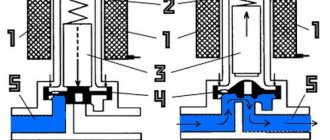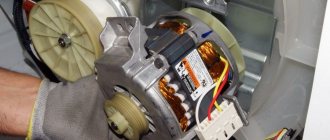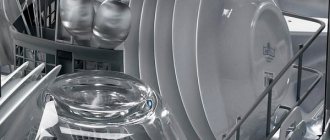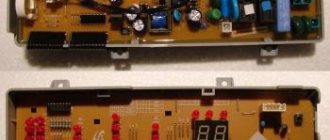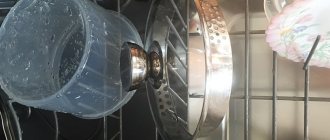Checking the correct use of the dishwasher
Often the cause of many malfunctions is failure to follow the manufacturer's instructions for operating the equipment. It is important to check that the dishwasher is being used correctly. First of all, you should make sure that there is water flowing into the tap. In apartments, water is supplied to the kitchen by one riser. If there is no water coming into the faucet, the dishwasher will not get any water either. Interruptions in the water supply often lead to temporary problems with the dishwasher.
It is important to use a suitable and high-quality detergent. The use of low-quality household chemicals can lead to serious malfunctions of the dishwasher. Usually the manufacturer gives recommendations regarding the choice of detergents.
The water supply valve may be closed. The mechanism is located at the point where the device hose connects to the water supply system. When the tap is closed, the equipment cannot draw water, so it must be opened.
The supply hose is clogged or kinked
The reason that water does not flow may be a simple clog in the dishwasher hose. Just as in the previous case, the problem can easily be fixed with your own hands. Prepare a large basin first, then unscrew the hose from the filling filter and drain the water into a previously prepared container. If blockages are observed, completely disconnect the hose and rinse it thoroughly under running water. Next, the hose needs to be put in place. During installation, make sure that there are no kinks and check that the gaskets are installed correctly.
By the way, water may not flow or flow poorly even if the hose is pinched. So check this point.
What to check first
The reasons why water does not flow into the machine are the same for dishwashers from Beko, Bosch, Ariston and others. The most modern models of dishwashers include the Aquastop system; sometimes it is this system that fails, but there are other problem areas.
Tap water
The first thing they do is go to the sink if the dishwasher hums when turned on, but does not fill with water. Open the tap. The sound of hissing and lack of water explain the cause of the malfunction. The device is working properly, there are problems with the water supply.
The door is not closed tightly
This is the most common reason. Many housewives are in a hurry and do not close the door all the way. In this case, the blocking is triggered. The indicators on the control panel are on, but the unit is silent. Water does not fill, the pump does not make noise. The problem can be easily solved. The door is opened and closed again until it clicks.
Water supply valve
When leaving the house (apartment) for a long period of time, the owners turn off the valve that connects the dishwasher hose to the water supply system. Upon returning, they forget to open it, turn on the device, and feel frightened.
If water does not flow into the machine, check the valve first.
Hose
Tap water can get scale and other debris into the device. It can damage the machine. To prevent this from happening, a mesh filter is installed at the point where the hose connects to the water supply network. When the mesh on the filter becomes clogged, water flows poorly into the tank, the dishwasher hums, but does not work.
This malfunction can be easily eliminated:
- unscrew the hose;
- remove the strainer;
- large particles are removed from it;
- the holes are cleaned with a needle;
- the plaque is cleaned off with a solution of citric acid, the strainer-filter is lowered into it for 1-1.5 hours.
Loading door
If your Bosch dishwasher does not fill with water, you need to check whether the loading door is tightly closed. The fact is that the device is designed in a certain way - until the lock is activated, the washing cycle will not begin.
There are several reasons that caused this problem.
- The first one is simple. It lies in the fact that the owner simply did not close the door tightly. Sometimes containers or baskets may not be installed correctly. They are the ones who prevent you from closing the door.
- The second is more serious. It occurs due to a broken lock. In this case, only repair or replacement of the part with a new one will help.
- The third reason why water may not be drawn is that the device is not set at the correct level. Because of this, a slight deformation occurs, which does not allow the door to close.
- And the last reason is damage to the rubber seal. It is worth noting that even the slightest deformation can affect the door not closing tightly.
If your Bosch dishwasher does not draw water due to a broken door lock, you can replace it yourself. To do this you will need to buy a new part. The installation is quite simple:
- After opening the door, you need to unscrew the fastener.
- Remove the terminal with the connected wires.
- Unscrew the screws that secure the lock.
- Secure the new one and connect the terminal.
- Install the top door panel and tighten the fastening screws.
When replacing an old lock with a new one, do not forget about the latch.
Fill valve broken
The reasons why water cannot get into the dishwasher may be related to the operation of the fill valve. This valve is a rather sensitive element of the dishwasher and even a pressure drop can damage it. In particular, manufacturers of Bosch dishwashers in the instructions for their products indicate recommendations for installing a dishwasher if the pressure in the water supply is above 1 MPa. In addition to flow-through cleaning filters, they recommend installing pressure reducing valves.
If there is no pressure relief valve, and the water pressure is significant, then the dishwasher’s own fill valve will quickly break and either will not open at the right time, or, on the contrary, will remain open and water will constantly flow into the machine. In this case, it is almost impossible to repair the valve, because the mechanism breaks down and will have to be replaced. If the valve is simply clogged with dirt and does not open, then the problem can be solved by ordinary mechanical cleaning.
The water level sensor is to blame
The Bosch dishwasher seems to be humming and the lights are still on, but why doesn’t the water pour in? The culprit of this disgrace may be the pressure switch of the dishwasher. This device, also called a water level sensor, is required to accurately determine how much water is in the car at a given time. But the problem is that at one not very wonderful moment he may refuse to perform his function and then the following will happen:
- water will actually flow into the dishwasher, but the control module will not know about it;
- the machine will overflow and the pump will begin to pump out excess water in emergency mode;
- the control module, thinking that water is not flowing into the machine, generates a system error and stops the program.
It is not difficult to understand that this is exactly what happened to your dishwasher. Listen to whether there is water in the dishwasher, whether the pump is working, pumping out water, and whether the water is babbling in the drain hose and pipe. If all this takes place, then the first version that will need to be checked is a breakdown of the pressure switch. You can read about how to check and replace the pressure switch in the corresponding article published on our website.
Intake valve failure
The inlet valve is a complex mechanism, the principle of operation of which is similar to the operation of a conventional water supply valve, however, unlike it, all procedures for supplying and stopping the flow of water occur automatically. Most often, the inlet valve is damaged by dirt particles that were not retained in the fill valve filter and penetrated further. Therefore, we repeat once again, try to place a filter at the water inlet and regularly clean the inlet filter.
If trouble occurs and the spare part is damaged, do not be upset. You can replace this unit yourself if you have access to it. Do not forget to first unplug the plug from the socket and wait 15 minutes to discharge the capacitor.
How to replace the intake valve:
- Disconnect the supply hose and remove the part from the dishwasher body.
- Remove the clamp from the internal pipe of the device. Please note that many manufacturers install one-time clamps in the equipment in question. Therefore, first, along with the inlet valve, do not forget to order and buy a stainless steel clamp with a tightening screw.
- In the next step, remove the hose by helping yourself with the tip of a screwdriver (do not try to pull on it, as this will complicate the situation even more).
- Before removing the electrical contacts, be sure to mark them for convenience. If the tips are difficult to remove, help yourself with a screwdriver. If the connections are soldered, it is better to contact a service center to replace the valve.
- After the spare part has been replaced, install all elements in the reverse order. If the valve has a plastic curtain to protect it from water getting into it, do not forget to put this part in place in time.
When does the dishwasher not fill with water?
Sometimes situations arise when the dishwasher cannot draw the required amount of water within a certain period of time set by the manufacturer (for example, 10 minutes). In such cases, the PMM stops working, sometimes buzzes, and the display shows an alphanumeric error code. For example, dishwashers from Bosch and Siemens signal a similar emergency situation with codes E3, E8 or E15.
Error codes E3 and E8 appear when the PMM does not take in water
Liquid may not flow into the dishwasher tank for reasons that are easy to find out and fix yourself:
- There is no water in the water supply or its pressure is very low. This is easy to determine - turn on the faucet in the bathroom or kitchen.
- The water stop valve located at the entrance to the apartment or at the outlet of the tee through which liquid is supplied to the dishwasher is closed.
- Careless handling of the door resulted in the blocking sensor not working. In this case, the liquid will not flow into the PMM until the door is tightly closed.
- The inlet hose through which water enters the dishwasher is pinched. This may happen due to rearrangement of furniture or other reasons. Checking and restoring its patency is quite simple.
If you pull the inlet hose, it will bend and will not allow water to pass through.
In the above situations, restoring the water supply and the functionality of the PMM is quite simple, and anyone can do it. But there are more complex problems, the elimination of which requires certain knowledge and skills:
- The flow or inlet coarse filter is clogged. Typically, the inlet filter element is located where the inlet hose connects to the dishwasher body.
- The Aquastop protective module, which shuts off the water supply if there is a liquid leak in the dishwasher, has worked or failed (error code in the Bosch, Siemens PMM - E15).
- The device that locks the front door of the dishwasher has stopped working. In this case, the electronic control unit (hereinafter also referred to as the ECU) does not receive a signal to close the door and stops working.
- The inlet valve does not open (failure may be caused by a blockage or water hammer in the water supply system). There may be a missing control signal from the ECU.
- The water level sensor in the PMM tank (hereinafter also referred to as the pressure switch) is faulty. It may send an erroneous signal to the ECU that fluid has already been filled.
- The electronic control unit of the dishwasher has failed and does not provide a control signal to open the inlet valve.
Possible malfunctions due to which water does not flow into the dishwasher
If the matter is not inattention and lack of liquid in the water supply, then you should familiarize yourself with the malfunctions that most often lead to this problem:
- The flow filter or the entire system is clogged.
- The fill valve broke, blocking the water supply.
- Door mechanism malfunction.
- Pressostat failure.
- Triggering of the Aquastop system.
- Damage to the control unit element.
Diagnosis of the causes and troubleshooting of the dishwasher
The most common reasons why your dishwasher won't fill with water include:
- the door is not tightly closed because the door lock is broken;
- the filter is clogged;
- the Aquastop system has blocked the fluid supply;
- the temperature sensor has broken or the heating element has burned out;
- problems with the control module;
- the filling valve has failed;
- The water level sensor is broken.
Some of the reasons can be eliminated yourself, for example, by cleaning the filters. More complex breakdowns require certain knowledge and special tools.
Advice. If your dishwasher is under warranty, contact a professional immediately.
The door is not closed tightly
The device door has a lock that protects it from leaks. When it is closed, the control module receives a signal that the door is locked, and the machine starts working. If the lock is broken, the door does not close until it clicks. There is no blocking signal, the program does not start and liquid is not collected.
If the lock breaks, you can change it yourself. How to do it:
- the dishwasher is disconnected from the power supply;
- unscrew the front panel;
- unscrew the broken door lock;
- install a new latch;
- screw the panel.
Filter clogged
An inlet valve filter is installed to protect equipment from dirt and debris that comes from the water supply. It is periodically cleaned or replaced. If liquid is drawn into the dishwasher too slowly or does not flow at all, then the reason is most often a clogged filter. They clean it on their own or call a professional.
Before cleaning, turn off the water supply. Unscrew the hose and remove the filter. It is located at the inlet of the intake valve. The mesh is washed under running water. If it is heavily soiled, clean it with a needle or dip it in a solution of citric acid (30 g per 1 l) for an hour. Then the cleaned filter is installed again and the hose is connected.
Aquastop worked
Dishwashers are equipped with a leakage protection system - Aquastop. Reasons why equipment stops working:
- the solenoid valve blocked the water supply due to a leak;
- the system itself failed.
Possible reasons
The German company Bosch produces very reliable household appliances and units, but they are not immune from annoying problems - it is useless to complain that you were sold a low-quality car. Most likely, water does not flow into the machine due to reasons to which manufacturers of modern equipment are not involved.
Experts have compiled a short list of the real reasons for this failure:
- There is no water flow into the home plumbing system.
- The water supply valve to the machine is closed.
- The inlet hose is pinched or bent.
- The Aquastop or Aqua-Control system detected a leak and blocked the water intake.
- Due to power surges in the network, the water inlet solenoid valve has failed - urgent replacement is required.
- The loading door is not closed tightly or the locking system is faulty.
- The water level sensor in the tank is broken, it provides incorrect information to the control module - as a result, water filling is stopped.
- The intake valve strainer is clogged - the problem can be solved quite quickly, we dismantle it and wash it.
- A broken Bosch control module is the most serious problem of all; it needs urgent replacement.
You should not try to diagnose the machine yourself if the module breaks down - this may lead to replacing the unit with a new one ahead of schedule.
If you value an assistant, then contact the professionals, everything will be done quickly and with a guarantee.
Decoding errors
All dishwasher models have a self-diagnosis program. It protects the device from serious damage. In critical situations, an error code appears on the electronic display; the meaning of each is given in the operating instructions.
In any models, errors are grouped into categories:
- malfunctions of drainage and water supply;
- deviations in the water heating process;
- malfunctions of water sensors and switches;
- electrical problems.
The instructions for each error code contain a description of the probable malfunction and how to eliminate it. In the table of malfunctions of BOSCH models.
| Code | Decoding |
| E27/F27 | There was a power surge |
| E22/F22 | The filter is clogged |
| E01/F01 | Problems with the electronic unit |
| E3/F3 | No water coming in |
| E15/F15 | The leakage protection system has activated |
| E09/F09 | The heating element does not work |
| E24/F24 | Waste fluid does not drain |
| E25/F25 |
Let's look into it in detail
If there is no water in the water supply, then you need to be more careful and read the warnings on the notice board in front of your entrance - the Housing Office always warns residents about possible water outages due to maintenance work. It is not difficult to check whether the water supply tap to the dishwasher is open and the condition of the inlet hose; however, it is not difficult to determine whether the aqua-stop has worked or not.
Inlet valve
This part is available on absolutely all brands and models of dishwashing machines. If it is faulty, then water will not be drawn into the unit’s system, because the valve will not be able to open access to the inlet hose.
Voltage drops constantly occur in the city electrical network, so excess voltage may be supplied to the electromagnet winding, causing it to burn out. If the winding is faulty, then the signal does not arrive at the rod, and the elastic rubber membrane continues to block the input.
This product cannot be repaired - it needs to be replaced. If you do not understand anything about the technical features of household appliances, then it is better to invite a technician from the service center.
Important! When replacing the solenoid inlet valve yourself, remember that it must match the brand and model number of the dishwasher.
Many home craftsmen successfully and without problems cope with such a replacement and save the family budget.
Loading door
As long as it is not closed tightly, the machine will not work. You need to press it until you hear a characteristic click; if even after that the water intake does not start, then the reason is in the blocking system. What to do in this case? First of all, do not panic, unplug the machine and carefully inspect all the door elements:
- deformation, even the slightest, of the sealing rubber always leads to the door not closing tightly;
- we inspect the lock - if faults are found, we replace it or repair it;
- we check the installation of baskets and containers - if installed incorrectly, they prevent the door from closing tightly;
- If the machine is not level, the door may not close completely due to extraneous interference.
If the reason for the loose closure is a lock, then you can replace it yourself, just purchase a new lock specifically for your model in advance. The lock replacement algorithm is quite simple:
- Open the door and unscrew the fastening screws. Carefully! The edges of the stainless steel coating on the inside are very sharp - do not cut your hands. Hold the top panel so that it does not fall out.
- Carefully disconnect the wire connection terminal.
- Unscrew the fasteners on the top and move the lock to the side.
- We install the new one in place and connect the terminal.
- We insert the top panel into place and tighten the fasteners.
The replacement was successful, now we need to install a new latch so that all the parts are new. The master in this video will explain how to do this.
Some home craftsmen, in order to save money, repair a faulty lock by replacing broken plastic parts with more durable ones made of stainless metal. No one gives a guarantee that such a lock will work longer than the factory one, so why waste energy and reinvent the wheel?
Cleaning the filter
Quite often, the dishwasher does not draw water precisely because the mesh filter is clogged, because the water is hard and its deposits clog the mesh of the filter element. We do everything ourselves:
- close the tap, disconnect the inlet hose from the machine;
- at the connection point, there is a small filter inside - take it out and rinse it under running water;
- if the mesh is very clogged, you can immerse it in citric acid for half an hour.
Then we put everything in its place and try to draw water, everything works - the repair is completed.
Causes of breakdowns
Most often, those components and elements of the dishwasher that fail are those that are subjected to mechanical stress during operation, have a complex design, or are in contact with poor-quality water. The causes of breakdowns are also associated with the listed factors.
Filter clogged
Tap water in our country is rarely absolutely pure. Various impurities, sand, rust and other debris are regularly supplied to our houses and apartments along with water.
These contaminants can damage the PMM, so all manufacturers proactively provide protection for their products from dirt. It is performed in the form of an input filter. Its mesh traps all the debris, but after some time it can become completely clogged and block the flow. Quite often, a hum is heard and the washing does not start.
In dishwashers, it is located on the inlet hose, at the point of connection to the body. Accordingly, you need to unscrew it, having first shut off the water supply to the riser.
External water supply problems
Problems arise not only due to a broken dishwasher, but also due to interruptions in the water supply. There may be no water supply either in the water supply itself or in the inlet hose.
A closed tap will also prevent you from using an automatic wash.
Aquastop failure
Violation of the tightness between the dishwasher components leads to the appearance of water in the pan. There is a leakage sensor there. If it works and gives a signal, the control system will automatically stop filling with water.
Sometimes false alarms occur when the sensor itself fails.
Problems with the door
The dishwasher door has a complex design and problems with it are not uncommon. There may be several reasons for this to not work:
- The locking mechanism is malfunctioning and the door cannot close completely. Because of this, the sensor does not work and the device does not start;
- the door lock is broken;
- The closing sensor does not work.
Sometimes all of the above happen at the same time.
Failure of the pressure switch
The volume of water poured into the dishwasher is monitored by a special device - a pressure switch. It is through it that the control board gives commands to start and stop water supply. If it does not work correctly, then it is possible that either the tank overflows and the “aquastop” is triggered, or the flow of water does not begin at all.
Caution – module failure!
Under no circumstances should you repair a Bosch dishwasher yourself if the control module has failed in the appliance. This problem is rare, but it is the most serious. It is because of a malfunction in the electronics that the machine does not draw water.
In this case, you will need to remove the module and test it in the laboratory. Sometimes specialists reflash it. If this does not give any results, then you will need to install a new one.
Qualified service center employees strongly recommend that in the event of a breakdown, do not diagnose the control module yourself, as this may lead to its final failure. Professionals will handle this much faster and better. In the end result, although you will have to pay for the repairs, you will be provided with a guarantee for the work.
Troubleshooting problems with water supply to the PMM
If you have already checked everything that is possible, but water still does not flow into the system, then you need to inspect individual parts. Start by cleaning the filter and hose:
- close the shut-off valve;
- unscrew the inlet hose;
- behind it there is a filter mesh;
- rinse the parts under pressure from the tap; you can use a small brush to clean the hose.
At the same time, you can check the remaining details.
Fill valve
If water is not supplied to the Bosch dishwasher, the intake valve is inspected first. Visually check for mechanical damage on the surface of the part. To test the electronics, you need to apply voltage to the element, which will show whether the membrane opens or not.
The electrical part is tested with a multimeter, the resistance is measured and a verdict is made.
The intake valve cannot be repaired. You will need a complete replacement of the element, which you can do yourself. Disconnect the wiring and unscrew the screw securing the part. The main thing is to select an original spare part for the make and number of your car.
Hopper door
Until the chamber door is tightly closed, the machine will not start working. What if the door does not close all the way? Check:
- Seal. When it becomes deformed or comes out of its seat, it can interfere with normal closure.
- Latch. A broken lock will not make the door “click” and the system will not start.
- Placement of baskets and other camera elements. There may be something preventing the door from closing.
- Installation of PMM. Check the placement of the machine using a building level.
How to install a new door lock:
- open the bunker door;
- Unscrew the bolts around the perimeter of the inner part;
- remove the outer panel;
- disconnect the wiring;
- Unscrew the fastening screws and remove the lock;
- install the new element and connect the wiring.
- reassemble in reverse order.
We do not recommend replacing individual broken parts when trying to repair an old lock. This does not guarantee long-term use.
"Aquastop" system
First of all, check if there is any water in the pan. When a leak occurs, the protection float floats up, presses on the switch, and the water intake is blocked. When “Aquastop” is activated in the dishwasher, fault code E15 may appear on the display.
What to do:
- unscrew the hose from the body (if you have a mechanical Aquastop);
- look at the valve inside: if it is pressed tightly against the walls of the hose, then the protection needs to be replaced;
- To do this, disconnect the old hose and install a new one.
If you have an electromagnetic device, then additionally connect the wire to the sensor.
Level sensor
Incorrect pressure switch readings can also cause a lack of water. We wrote how to replace the level sensor in one of the articles. Most often, the device is a plastic box that is attached to the circulation pump. Checking its mechanics is very simple - blow into the pressure tube. If you hear clicks, the pressure switch is working.
The electrician is checked with a multimeter.
Electronic module
Modern Bosch dishwashers are equipped with a control module. He manages all processes in the machine and gives commands to the nodes. For example, drain the water from the bunker or start drawing water. If one of the board's triacs burns out, then some part stops functioning. Therefore, the module requires flashing or replacement.
Only a specialist can diagnose and repair the electronic board.
You can check the parts in your Bosch dishwasher yourself. Sometimes the reasons for the lack of water lie in a small blockage, so before calling a technician, make sure that the breakdown really exists.
No water supply
If there is no water supply to the appliance at all, and the pressure in the central water supply is normal, then there is definitely a problem with the dishwasher itself. This malfunction can occur if there is a short circuit in the network. It leads to electronic failure, engine malfunction, in particular to short circuit or breakage of winding turns. In both the first and second cases, it is better to contact a service center to carry out a full diagnosis and find out the reasons why water is not being drawn.
List of provoking factors depending on the dishwasher model
All dishwashers work on the same principle. But everyone has different spare parts, different software, different “weak” points:
Indesit - the most common problem with water intake is related to the filling system; it needs to be cleaned more often.- For Zanussi, the weak point is the filling valve.
- Beko's water level sensor falls off more often than other models. This leads to water overflow or no water at all.
- In the second generation of dishwashers from the Bosch model range, the lack of water supply is due to an electronic control failure. The machines are very sensitive to low water pressure.
- The third generation of the Bosch model range has increased sensitivity to excess pressure. With it, the “electronic sensor” does not have time to “track” the filling of water and stops the program.
What caused the problem
This problem is typical for all PMM models: Ariston, Indesit, Veko, Siemens and others. Why doesn't water fill or flow into the machine? Let's look at typical problems that a user may encounter:
- Lack of water in the water supply. It's that simple. There might be a shutdown notice on your door, or maybe there's a problem. Turn on the bathroom faucet and test your guesses. If everything is in order with the water supply, then proceed to the next step.
- The hopper door is not fully closed. If the blocking does not work, water intake will not begin. Press the door firmly until it clicks, after which feeding should resume.
- The shut-off valve is closed. If water does not flow, check the valve located on the water pipe. It serves for emergency shutdown in case of an emergency. It may have been blocked - then unscrew it.
- The inlet hose is kinked. It could be pinched or bent, which impedes the flow. Restore the hose to its normal position.
- Weak pressure. This happens when there is not enough pressure in the system to enter the dishwasher. All that remains is to wait until normal supply resumes.
Have you checked everything point by point, but there is still no water supply? So it's not a matter of minor problems. We will tell you what to do in this case and how to deal with the breakdown.
Damage to the pressure switch level sensor
If water does not flow into the dishwasher, you need to adjust the water supply level and send a signal to the board that produces the machine's pressure switch. This part is equipped with a liquid volume level sensor in the chamber. Due to its multi-functionality, the washing program requires different volumes of liquid. A pressure switch is provided for the automated washing program and to control the filling of the required amount of water into the chamber.
Dishwashers are equipped with two types of pressure switch:
- Mechanical - in this type the membrane fails.
- Electronic is a complex device where it is possible to determine the breakdown only using a tester with an error code recognition program.
There are characteristic signs of a malfunctioning pressure switch. For example, when liquid is supplied to the system, liquid is overfilled or underfilled into the chamber. After filling the tank with water, it is drained, the equipment stops working with a full tank, and the drain does not pump out water. The reason may be:
- sensor element failure;
- the contacts are weakly fixed, which causes an increase in the temperature of the wiring;
- The pressure hose is clogged due to debris.
Work must be carried out in the following order:
- Disconnect the equipment from the power supply and water supply system.
- Install the soft stop and turn it over to the back.
- Unscrew the screws and unfasten the latches of the bottom cover.
- Using pliers, disconnect the tube from the camera and inspect for any blockages.
It is not difficult to diagnose the mechanical part of the sensor: you need to blow into the pressure sampling tube, clicks should be heard from the pressure switch. This means that the switch has actuated and the device is in working order.
The electronic one is checked with a multimeter. To do this, you need to connect the probes to the contacts; if the reading is zero, the pressure switch is working properly. If there is a malfunction, the sensor should be replaced. To do this, you need to disconnect the tube and contacts.
